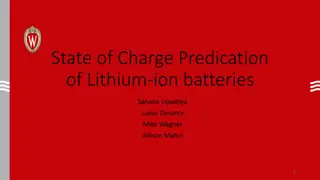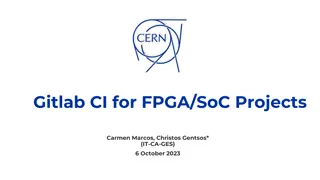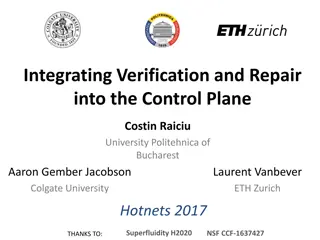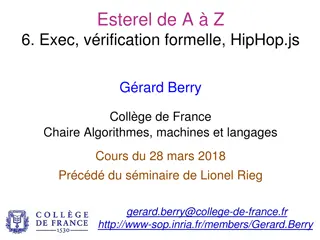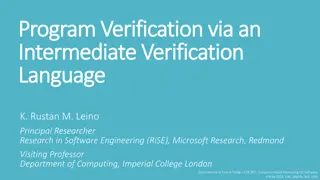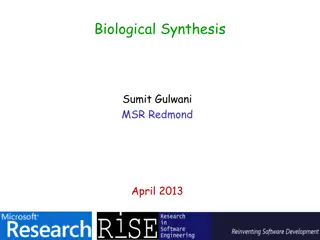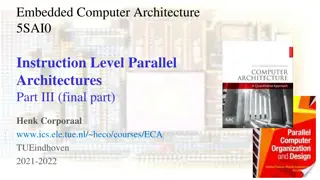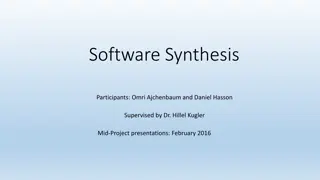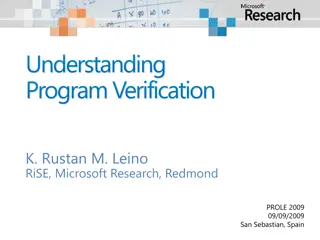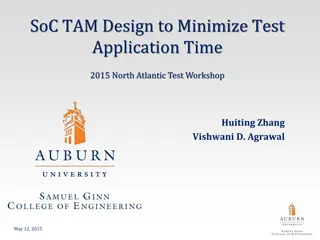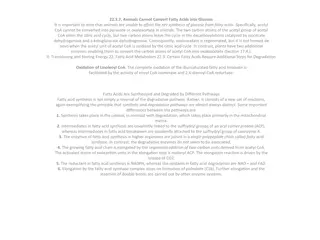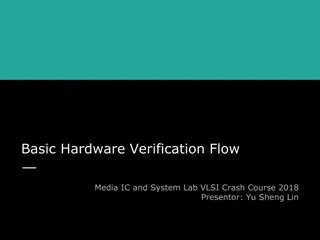Template-Based Synthesis of Instruction-Level Abstractions for SoC Verification
This work explores template-based synthesis of instruction-level abstractions for system-on-chip (SoC) verification, presenting insights into the importance and implementation of Instruction-Level Abstractions (ILA) in SoC design. The content covers various units within an SoC, including CPU, GPU, camera, interconnect, memory, DMA, and more, emphasizing the role of ILA in improving verification processes and hardware functionality.
Download Presentation

Please find below an Image/Link to download the presentation.
The content on the website is provided AS IS for your information and personal use only. It may not be sold, licensed, or shared on other websites without obtaining consent from the author.If you encounter any issues during the download, it is possible that the publisher has removed the file from their server.
You are allowed to download the files provided on this website for personal or commercial use, subject to the condition that they are used lawfully. All files are the property of their respective owners.
The content on the website is provided AS IS for your information and personal use only. It may not be sold, licensed, or shared on other websites without obtaining consent from the author.
E N D
Presentation Transcript
Template-based Synthesis of Instruction-Level Abstractions for SoC Verification Pramod Subramanyan, Yakir Vizel, Sayak Ray and Sharad Malik FMCAD 2015 CPU ISA GPU ILA Camera ILA Touch ILA Flash ILA On-chip Interconnect ILA ILA ILA ILA ILA ILA MMU+ DRAM DMA WiFi/3G GPS This work was supported in part by CFAR, one of the six SRC STARTnet centers, sponsored by MARCO and DARPA
2 Template-based Synthesis of Instruction-Level Abstractions for SoC Verification Why an ILA? CPU GPU Camera Touch Flash Microcontroller On-chip Interconnect MMU+ DRAM Memory DMA WiFi/3G SCIP HW accelerators Firmware running on the microcontroller orchestrates the operation of each unit NoC interface
3 Template-based Synthesis of Instruction-Level Abstractions for SoC Verification Why an ILA? AES mem range C registers RSA mem range Microcontroller SHA mem range ALU Memory Interconnect Inst Seq. HW accelerators Memory Private Memory FW uses memory-mapped I/O to monitor/control HW NoC interface Insight: Treat MMIO reads/writes as part of an extended ISA aka ILA
4 Template-based Synthesis of Instruction-Level Abstractions for SoC Verification Why an ILA? Instruction is now any firmware-visible state update triggered by some event ; start AES state machine MOV MOV MOVX ACC, #01 DPTR, #0xFF00 @DPTR, ACC IDLE READ WRITE ENC ; poll for completion wait_finish: MOV MOVX CMPI JNZ DPTR, #0xFF01 ACC, @DPTR ACC, #00 wait_finish Instruction-Level Model of HW accelerators Instruction-Level Model of c ISA Instruction-Level Abstraction (ILA) of SoC
5 Template-based Synthesis of Instruction-Level Abstractions for SoC Verification What does the ILA look like? For a microcontroller Input State Output State opcode = ROM[PC]; switch (opcode) { case 00: REGS[ACC] = ...; REGS[R0] = ...; REGS[FLAGS] = ...; REGS REGS PC PC Transition Relation case 01: REGS[ACC] = ...; REGS[R0] = ...; REGS[FLAGS] = ...; ROM RAM RAM ... }
6 Template-based Synthesis of Instruction-Level Abstractions for SoC Verification What does the ILA look like? For a hardware accelerator Input State Output State switch (curstate) { case IDLE: if (rdaddr == RDPTR_ADR) rdptr = datain; ... case READ: ... case AES1: ... case AES2: ... case WRITE: ... } curstate curstate rdptr rdptr rdcnt rdcnt Transition Relation rdbuf rdbuf wrptr wrptr wrlen wrlen wrbuf wrbuf ... ...
7 Template-based Synthesis of Instruction-Level Abstractions for SoC Verification Our Contributions New components Automatically generated Existing tools Existing components (1) Concept of the ILA FW verification (2) Template language and Synthesis algorithm Instruction- Level Abstraction Template abstraction Synthesis Algorithm Golden Model (3) Verifying ILA correctness Model Checker Simulator RTL Challenges in constructing the ILA ILA must completely define HW behavior Manual construction is tedious and error-prone Refinement Relations Bugs/counter examples
8 Template-based Synthesis of Instruction-Level Abstractions for SoC Verification ILA Synthesis using Program Synthesis Build on recent progress in the area of program synthesis [ASPLOS 06, ICSE 10, FMCAD 13, ] Transform a template-program with holes into a complete program using an I/O oracle x = (x & 0x5555) + ((x >> 1) & 0x5555); x = (x & 0x3333) + ((x >> 1) & 0x3333); x = (x & 0x0077) + ((x >> 1) & 0x0077); x = (x & 0x000F) + ((x >> 1) & 0x000F); loop (??) { x = ( x & ??) + ((x >> ??) & ??); } return x; return x;
9 Template-based Synthesis of Instruction-Level Abstractions for SoC Verification Synthesizing the ILA Main idea: synthesize the ILA from a template! Instruction- Level Abstraction How do we scalably synthesize ILAs? Template abstraction Synthesis Algorithm Equivalent of the program with holes Template language and synthesis formulation have to be designed carefully. Simulator Simulator is the I/O oracle
10 Template-based Synthesis of Instruction-Level Abstractions for SoC Verification Template Language Input State Output State Synthesis parameter: curstate Enables modular synthesis of transition relation curstate curstate rdptr rdptr rdcnt rdcnt rdbuf rdbuf Template ILA partially defines the transition relation between input and output states wrptr wrptr wrlen wrlen wrbuf wrbuf ... ... Defined by the verification engineer
11 Template-based Synthesis of Instruction-Level Abstractions for SoC Verification Template Language: Choice Primitive An Example Template op SRC1 = choice src1[R0 R7, IMM] SRC2 = choicesrc2[R0 R7, IMM] ADD_RES = SRC1 + SRC2 SUB_RES = SRC1 SRC2 INC_RES = SRC1 + 1 ALU_RES = choicealu_result [ADD_RES, SUB_RES, INC_RES, ] ALU imm opcode R0-R7 What is missing? No mapping of opcodes to operations No mapping of opcode bits to register values, immediates, etc. Synthesis algorithm can infer these details using simulation results!
12 Template-based Synthesis of Instruction-Level Abstractions for SoC Verification Template Language: Choice Primitive An Example Template op SRC1 = choice src1[R0 R7, IMM] SRC2 = choicesrc2[R0 R7, IMM] ADD_RES = SRC1 + SRC2 SUB_RES = SRC1 SRC2 INC_RES = SRC1 + 1 ALU_RES = choicealu_result [ADD_RES, SUB_RES, INC_RES, ] ALU imm opcode R0-R7 switch (opcode) case 00: ALU_RES = R0 + IMM; case 01: ALU_RES = R1 + IMM; case FF: ALU_RES = R7 R0 } Synthesis algorithm
13 Template-based Synthesis of Instruction-Level Abstractions for SoC Verification Summarizing the Template Language Expressions with bitvector and array datatypes (QF_ABV) Plus 3 synthesis primitives choice id[c1, c2, , ck] Replace this expression with one of c1 ck bv-in-range START END Replace with a bitvector bv s.t. START <= bv <= END read-slice-choice id bv-exp size Replace with a subvector of bv-exp of width size
14 Template-based Synthesis of Instruction-Level Abstractions for SoC Verification Synthesis Algorithm: CEGIS Family of relations defined by template Counter-example Guided Inductive Synthesis (CEGIS) 1. Finddistinguishing input: results in different outputs for some two relations 2. Evaluate simulator output for the distinguishing input 3. Eliminate functions from family which are inconsistent with simulator output 4. Repeat until distinguishing inputs cannot be refined any more
15 Template-based Synthesis of Instruction-Level Abstractions for SoC Verification Synthesis Algorithm on Toy Example SRC2 ADD_RES SUB_RES R0_NEXT = choicesrc2 [R0, R1] = R0 + SRC2 = R0 SRC2 = choicealu_result [ADD_RES, SUB_RES] R0 ALU Iteration Opcode R0_in R1_in R1_out 2 #1 0 0 0xE8 0 mux 8 #2 0 0x68 0 0xD0 8 R0 R1 opcode After iteration #2 R0=R0+R0 R0=R0+R1 R0=R0-R0 R0=R0-R1 switch (opcode) { case 0: R0 = R0+R0; case 1: R0 = R0-R0; case2: R0 = R0+R1; case 3: R0 = R0-R1; } After iteration #1 Synthesized ILA
16 Template-based Synthesis of Instruction-Level Abstractions for SoC Verification Correctness of the ILA Defines a family of ILAs Instruction- Level Abstraction Template abstraction Synthesis Algorithm Simulator RTL Potential Problems: Simulator behavior may not lie within the family defined by the template Simulator/RTL mismatch ILA/RTL mismatch
17 Template-based Synthesis of Instruction-Level Abstractions for SoC Verification Synthesis Correctness Defines a family of ILAs Instruction- Level Abstraction Template abstraction Synthesis Algorithm Simulator If simulator behavior falls within the family functions defined by the template, then the synthesized ILA is equivalent to the simulator.
18 Template-based Synthesis of Instruction-Level Abstractions for SoC Verification Verifying the ILA Instruction- Level Abstraction Golden model is automatically Template abstraction generated from the ILA Synthesis Algorithm Golden Model Model Checker Simulator RTL Refinement relations are written by the verification engineer and specify that ILA and golden model have equivalent I/O behavior Refinement Relations
19 Template-based Synthesis of Instruction-Level Abstractions for SoC Verification Refinement Relations for ILA Verification From [McMillan, 1999] Golden model only executes when inst_finished=1 8051 Verilog Golden Model Model Checker if (inst_finished) { ACC = PC = R0 = } else { // do nothing } ROM = inst_finished oc8051 RTL Relations are in the following form: G (inst_finished => (gm.ACC == oc8051.ACC) ) G (inst_finished => (gm.R0 == oc8051.R1) ) ... Compositional refinement relations enable scalable verification
20 Template-based Synthesis of Instruction-Level Abstractions for SoC Verification Test Case: Example SoC 8051 c XRAM I/O Ports REG ALU ARB RAM ROM AES SHA 8051 ILA AES+SHA+XRAM ILA Consists of components from OpenCores.org and OpenCrypto project Created two ILAs: 8051 core and AES+SHA+XRAM
21 Template-based Synthesis of Instruction-Level Abstractions for SoC Verification Implementing the Framework FW verification Python library using Z3 Python library Instruction- Level Abstraction Template abstraction Synthesis Algorithm Golden Model Yosys Model Checker Yosys Simulator RTL ABC i8051sim [UC Riverside] OpenCores.org OpenCrypto Refinement Relations Python simulator for AES+SHA+XRAM Tools/components developed by us Existing* tools and components
22 Template-based Synthesis of Instruction-Level Abstractions for SoC Verification Summarizing Synthesis Results Templates are fairly easy to write: several hundred LoC Synthesis usually done in tens of seconds; worst case is a few hours Helps validate simulator: 6 bugs were found
23 Template-based Synthesis of Instruction-Level Abstractions for SoC Verification Summarizing Verification Results Initial Model BMC up to 17 cycles (5-6 insts) in 5 hours Found six RTL bugs Compositional Model BMC up to depth of 35 cycles in 2000s Proved (PDR) 56-238 instructions correct
24 Template-based Synthesis of Instruction-Level Abstractions for SoC Verification In Conclusion FW verification https://bitbucket.org/spramod/fmcad-15-soc-ila Instruction- Level Abstraction Template abstraction Synthesis Algorithm Golden Model Model Checker Simulator RTL Refinement Relations Can build complete ILA with manageable effort Found many non-trivial bugs Applied on commercial SoCs with promising results Can be proven correct
25 Template-based Synthesis of Instruction-Level Abstractions for SoC Verification Backup Slides
26 Template-based Synthesis of Instruction-Level Abstractions for SoC Verification Conclusion Methodology for Synthesizing Instruction-Level Abstractions for SoC verification What we have shown: Methodology can find real bugs Helps define precise and complete semantics for HW behavior Prove that the ILA matches the HW behavior All with a manageable amount of effort Has been applied on commercial designs Found bugs there too! Lots more details in the paper! https://bitbucket.org/spramod/fmcad-15-soc-ila
27 Template-based Synthesis of Instruction-Level Abstractions for SoC Verification 8051 ILA: Synthesis Results (1/3) Synthesis parameter is the opcode (# of opcodes = 256) Model Template ILA C++ simulator Behavioral Verilog LoC ~650 ~3000 ~9600 Size (kB) 30 kB 106 kB 360 kB Size of the Template ILA
28 Template-based Synthesis of Instruction-Level Abstractions for SoC Verification 8051 ILA: Synthesis Results (2/3) State Avg Time (s) Max Time (s) ACC 4.3 8.5 B 3.6 5.1 DPH 2.7 5.0 DPL 2.6 4.4 IRAM 1245.7 14043 P0 1.8 2.7 P1 2.4 3.8 P2 2.2 3.5 P3 2.7 4.6 PC 6.3 141.2 PSW 7.3 15.9 SP 2.8 5.0 XRAM/addr 0.4 0.4 XRAM/dataout 0.3 0.4 Synthesis times for each opcode
29 Template-based Synthesis of Instruction-Level Abstractions for SoC Verification 8051 ILA: Synthesis Results (3/3) Synthesis detects bugs if simulations results inconsistent with the family of functions defined by template ILA Found 5 bugs in the simulator 1. Signed/unsigned confusion in C++ [CJNE, DIV, DA] RAM[RAM[i]]: RAM is a signed char array tempAdd = RAM[ACC] + 0x60: tempAdd is short int 2. Typo in AJMP 3. DIV/0 definition was incorrect Methodology forces us to precisely definethe semantics for each instruction
30 Template-based Synthesis of Instruction-Level Abstractions for SoC Verification 8051 ILA: Initial Verification Setup Automatically generated Verilog golden model from ILA ROM is non-deterministically initialized RAM size was reduced from 256b to 16b Golden model only executes when inst_finished=1 8051 Verilog Golden Model Model Checker if (inst_finished) { ACC = PC = R0 = } else { // do nothing } ROM = inst_finished oc8051 RTL Properties in the following form: G (inst_finished => (gm.ACC == oc8051.ACC) ) G (inst_finished => (gm.R0 == oc8051.R1) ) ...
31 Template-based Synthesis of Instruction-Level Abstractions for SoC Verification 8051 ILA: Initial Verification Results 6 RTL bugs were found AJMP: PC used in target addr calc was a few bytes ahead Decoding bugs in JB/JBC/JNB Undefined SFR addresses return last read value Back-to-back reads of same SFR addressed in different ways Set carry flag Complement carry flag Read carry flag SETB CPL ADDC 0xD7 C A, B Reached BMC bound of 17 cycles in 5 hours 17 cycles is about 5-6 instructions
32 Template-based Synthesis of Instruction-Level Abstractions for SoC Verification 8051 ILA: More Scalable Verification Using compositional reasoning [McMillan 2001] Generate a golden model for each opcode (256 models) Implementation of other opcodes is abstracted away opcode=05 clk acc State Must Match Again ram P0 Pick a certain point in time Suppose all instructions have been executed correctly until this point And now we receive opcode = 05 Will this opcode be executed correctly? We make this argument for every opcode and every state element
33 Template-based Synthesis of Instruction-Level Abstractions for SoC Verification 8051 ILA: More Scalable Verification Using compositional reasoning [McMillan 2001] Generate a golden model for each opcode (256 models) Implementation of other opcodes is abstracted away opcode=05 clk acc State Must Match Again ram P0 LTL formula: ?? (?????? = 05 ????_????? ?? ??) ? is a formula which says that all state until now matches Sg is the value of the state element in the golden model Sr is its corresponding value in the RTL
34 Template-based Synthesis of Instruction-Level Abstractions for SoC Verification 8051 ILA: Final Verification Results Property BMC Bounds 20 25 0 0 0 0 0 Proofs CEX 0 1 0 0 0 30 10 39 36 0 0 35 204 191 193 239 239 PC ACC IRAM XRAM/data XRAM/addr 25 8 10 0 0 96 56 1 238 238 Much higher BMC bounds and quite a lot of instructions proven correct!
35 Template-based Synthesis of Instruction-Level Abstractions for SoC Verification What does an SoC consist of? CPU GPU Camera Touch Flash On-chip Interconnect MMU+ DRAM DMA WiFi/3G SCIP Many units interacting with each other through an on-chip interconnect
36 Template-based Synthesis of Instruction-Level Abstractions for SoC Verification Example SoC Flow CPU GPU Camera Touch Flash MMU+ DRAM DMA WiFi/3G SCIP 1. SCIP programs DMA to read from flash 2. DMA writes command to flash 3. Flash returns data to memory 4. SCIP locks memory region 5. SCIP fetches data and checks signature 6.
37 Template-based Synthesis of Instruction-Level Abstractions for SoC Verification Verifying System-Level Properties Verification Requires CPU GPU Camera Touch Flash Model of the c ISA Model of DMA controller Model of the flash device Model of the MMU Model of SCIP crypto HW MMU+ DRAM DMA WiFi/3G SCIP 1. 2. 3. 4. 5. 6. SCIP programs DMA to read from flash DMA writes command to flash Flash returns data to memory SCIP locks memory region SCIP fetches data and checks signature Different from software verification because we need to model all the hardware state machines and special reads and writes to memory-mapped I/O locations
38 Template-based Synthesis of Instruction-Level Abstractions for SoC Verification Challenges in Constructing an ILA Must be precisely-defined and complete Security bugs lurk in corner cases, undefined behavior, illegal ops Mustmatch hardware behavior ILA must be verifiable If hardware doesn t match ILA, proofs made with it are invalid! Past work suggests manual construction which is Error-prone Cannot be verified to be correct Extremely tedious to construct
39 Template-based Synthesis of Instruction-Level Abstractions for SoC Verification Complexity in the Combinatorial Explosion Individual expressions are mostly straightforward Input State Output State opcode = ROM[PC]; switch (opcode) { case 00: REGS[ACC] = ...; REGS[R0] = ...; opcode = ROM[PC]; switch (opcode) { case 00: REGS[ACC] = ...; REGS[R0] = ...; REGS[FLAGS] = ...; REGS[FLAGS] = ...; REGS REGS PC PC Transition Relation case 01: REGS[ACC] = ...; REGS[R0] = ...; case 01: REGS[ACC] = ...; REGS[R0] = ...; REGS[FLAGS] = ...; REGS[FLAGS] = ...; ROM RAM RAM ... ... } } Combinatorial explosion that occurs as we have to define everything for every opcode makes the ILA hard to construct manually
40 Template-based Synthesis of Instruction-Level Abstractions for SoC Verification Generate ILA automatically? HW (RTL) Implementation Static Analysis Synthesized ILA Simulator Unfortunately this is not practical for realistic designs
41 Template-based Synthesis of Instruction-Level Abstractions for SoC Verification Why Is Verification Required? Ideal ILA In an ideal world, all of these are the same and no verification is needed! ILA defined by simulator But back in the real world, none of these are probably equal to any of the others! And so we do need verification. HW (RTL) Implementation Template ILA Family
42 Template-based Synthesis of Instruction-Level Abstractions for SoC Verification Synthesis Algorithm Correctness ILA defined by simulator Template ILA Family If Then Synthesized ILA ILA defined by simulator But note, we still don t know if HW (RTL) Implementation Synthesized ILA
43 Template-based Synthesis of Instruction-Level Abstractions for SoC Verification Verification Ensures That HW (RTL) Implementation Synthesized ILA This ensures that any firmware properties verified using the ILA are valid
44 Template-based Synthesis of Instruction-Level Abstractions for SoC Verification But What If HW (RTL) Implementation Synthesized ILA Ideal ILA As long as we can prove that our system-level properties hold, it doesn t matter!
45 Template-based Synthesis of Instruction-Level Abstractions for SoC Verification How is Verification Done? Write Refinement Relations to prove that the ILA and HW implementation have identical input/output behavior Refinement relations can be scalably model checked using compositional reasoning [McMillian, 2000] Details in the paper




